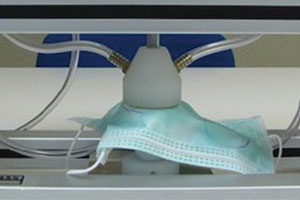CE marked masks are disposable masks approved by the European Economic Area for safety, health and environmental protection standards. EUROLAB Laboratory grades the respirators as N95, N99 or N100 according to their efficiency rating, grades the masks as FFP1, FFP2 or FFP3 for the TÜRCERT CE label.
The European Standard EN 149 defines the following classes of "filtering facial parts": FFP1 filters at least 80% of the particles; FFP2 filters at least 94% of the particles; FFP3 filters at least 99% of the particles.
On average, 5% of hospitalized patients are affected by health-related infections or 4.1 million patients per year in the European Union. 37.000 deaths each year result from such infections.
Infective agents can be transmitted in various ways during surgical procedures in operating rooms and other medical settings. One of the important sources is the nose and mouth of the surgical team. When breathing, talking, coughing or sneezing, a person releases less or more secretions of secretion from the mucous membranes in the mouth and nose. These droplets evaporate quickly and leave the nuclei suspended in the air. Nuclei can then spread to a sensitive area, such as an open-air wound or sterile equipment, or be inhaled if the dimensions are too small.
The surgical mask is a medical device that covers the mouth, nose, and chin, and provides a barrier that limits the passage of an infective agent between hospital staff and the patient. It was originally developed to contain and filter large droplets of microorganisms that are discarded from the mouth and nasopharynx of healthcare professionals during surgery, thereby protecting the patient.
The main purpose of wearing a surgical mask is to protect the user's direct environment from contamination.
Manufacturers have to characterize and classify surgical face masks in type I or II in the European market and in level 1, 2 ot 3 for the American market.
Evaluation of surgical masks in Europe
In Europe, surgical masks must wear a CE mark and comply with the requirements defined in EN 14683: Medical face masks - Requirements and test methods.
The standard defines surgical masks as follows: medical devices covering the mouth, nose, and chin provide a barrier that limits the passage of an infective agent between hospital staff and the patient.
Regarding performances, the mask is tested as a final product and must comply with different requirements.
The classification of masks in 4 classes is based on the results from the following tests:
- bacterial filtration efficiency (BFE)
- breathability (delta P)
- splash resistance (synthetic blood)
- microbial cleaning
- biocompatibility
Since surgical masks are considered class I medical devices, the manufacturer must perform a risk analysis and additional tests if necessary to respond to the European Medical Device Directive 2017/745.
There is no requirement for the barrier against inert particles.
TÜRCERT mask CE document supports all medical and medical device manufacturers.

